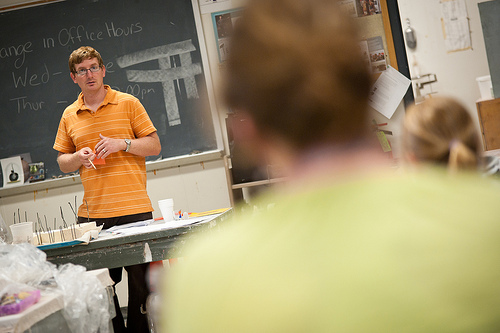Review Sessions: A Little Goes a Long Way
By Graduate Teaching Fellow, Nayana BoseTeaching assistants (TAs) are often assigned review sessions (RSs) as part of their duties. These review sessions pose some unique challenges, and in this blog post I will focus on two that I think are common across most disciplines.
- RSs are usually scheduled right before an exam when there is very little time to teach new topics to students who don’t already know it.
- RSs typically last an hour, and you are trying review material that has been taught over several classes.
While there is very little one can do to change this structure, we can definitely use some strategies that will make RSs useful for students and rewarding for TAs.
- Prioritize! Don’t even attempt to cover all of the
 material. It is not only impossible but the value added from trying to do this exercise is most likely not positive. As a TA, you know that there are probably 4 or 5 main concepts that are essential for students to know to answer the majority of the questions on the exam. If you can identify those for students then you can concentrate on developing these main ideas. You could also send out emails before a RS to ask which areas students want you to focus on. This will give you time to do justice to these topics, teach at a pace that everyone can follow, test student understanding (through problems or discussions), and reduce uncertainly about what kind of questions to expect on the exam.
material. It is not only impossible but the value added from trying to do this exercise is most likely not positive. As a TA, you know that there are probably 4 or 5 main concepts that are essential for students to know to answer the majority of the questions on the exam. If you can identify those for students then you can concentrate on developing these main ideas. You could also send out emails before a RS to ask which areas students want you to focus on. This will give you time to do justice to these topics, teach at a pace that everyone can follow, test student understanding (through problems or discussions), and reduce uncertainly about what kind of questions to expect on the exam. - Provide handouts. If you decide to focus on a few items during the RS, then you might be worried that you have not mentioned all the possible things that students need to know. This is when handouts are handy! Put all the things that you ideally would have loved to do in RS but did not have time to do. I think it is best to give these at the end of class so that students are not distracted trying to figure out what you are not covering.
- Show them the method to the madness. Before an exam it seems that there are a huge number of different concepts/formulas/ideas that students will need to remember in order to pass the exam. Usually, there are a few major concepts and several sub-concepts that are mostly modifications. It is extremely helpful to model this for students…show them how the ideas are related using tree diagrams, Venn diagrams, or concept maps. Although handouts are great, it is even more important to show the students how these ideas are built. While you are building the map/chart on one part of the board, you can introduce problems to mirror this gradual progression. This will help make abstract ideas more concrete.
- Model your thinking. Take the time to show how students should think about the problem and identify the critical idea being tested. I think using problems which have a few subsections are useful to test various concepts and also show how ideas are connected (as discussed in 3). So, if a problem has 4 or 5 subsections, you can use them to flesh out one of the main concepts that you are covering in the RS. This method allows students to see the point up to which they are comfortable with a topic and identify what they still need to work on. By taking time to establish the problem from the basic level means that students can see how to think about solving problems as they get progressively more challenging. The more challenging components will make the RS relevant for the students who already know most of the material. Note: don’t do problems in the RS that are so challenging that they take the whole session and are unlikely to be examples of exam problems. Be smart about how you allocate your limited time.
- Communicate with students and faculty. Before holding a RS, communicate with the faculty about the material that you are going to cover during the RS. Faculty input on what is relevant is beneficial for students and they will appreciate a RS that is designed for them. Also, use Office Hours to identify the points where students are most confused and need help. This will reduce your effort in trying to prioritize what you should cover in the hour that you have.
For TAs, the RS is an opportunity to practice your teaching and convey ideas to an audience in an organized and well planned format. The Center for Teaching has a lot of great resources on the website that you may want to use in your RSs and classes – how to lead discussion, use technology in the classroom, organize group work, use case studies, and or, my new favorite, flipping the classroom.

Leave a Response